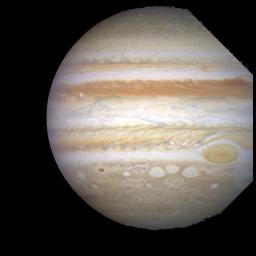Hubble Tracks Jupiter Storms
Caption:
NASA's Hubble Space Telescope is following dramatic and rapid changes in Jupiter's turbulent atmosphere that will be critical for targeting observations made by the Galileo space probe when it arrives at the giant planet later this year.
This Hubble image provides a detailed look at a unique cluster of three white oval-shaped storms that lie southwest (below and to the left) of Jupiter's Great Red Spot. The appearance of the clouds, as imaged on February 13, 1995 is considerably different from their appearance only seven months earlier. Hubble shows these features moving closer together as the Great Red Spot is carried westward by the prevailing winds while the white ovals are swept eastward. (This change in appearance is not an effect of last July's comet Shoemaker-Levy 9 collisions with Jupiter.)
The outer two of the white storms formed in the late 1930s. In the centers of these cloud systems the air is rising, carrying fresh ammonia gas upward. New, white ice crystals form when the upwelling gas freezes as it reaches the chilly cloud top level where temperatures are -200 degrees Fahrenheit (- 130 degrees Centigrade).
The intervening white storm center, the ropy structure to the left of the ovals, and the small brown spot have formed in low pressure cells. The white clouds sit above locations where gas is descending to lower, warmer regions. The extent of melting of the white ice exposes varied amounts of Jupiter's ubiquitous brown haze. The stronger the down flow, the less ice, and the browner the region.
A scheduled series of Hubble observations will help target regions of interest for detailed scrutiny by the Galileo spacecraft, which will arrive at Jupiter in early December 1995. Hubble will provide a global view of Jupiter while Galileo will obtain close-up images of structure of the clouds that make up the large storm systems such as the Great Red Spot and white ovals that are seen in this picture.
This color picture is assembled from a series of images taken by the Wide Field Planetary Camera 2, in planetary camera mode, when Jupiter was at a distance of 519 million miles (961 million kilometers) from Earth. These images are part of a set of data obtained by a Hubble Space Telescope (HST) team headed by Reta Beebe of New Mexico State University.
Background Info:
This image and other images and data received from the Hubble Space Telescope are posted on the World Wide Web on the Space Telescope Science Institute home page at URL
http://oposite.stsci.edu/
.
Cataloging Keywords:
| Name |
Value |
Additional Values |
| Target |
Jupiter |
Shoemaker-Levy 9 |
| System |
Jupiter |
|
| Target Type |
Planet |
Comet |
| Mission |
Hubble Space Telescope (HST) |
Galileo |
| Instrument Host |
Hubble Space Telescope |
Galileo Orbiter |
| Host Type |
Space Telescope |
Orbiter |
| Instrument |
Wide Field/Planetary Camera 2 (WFPC2) |
|
| Detector |
|
|
| Extra Keywords |
Ammonia, Atmosphere, Collision, Color, Haze, Infrared, Storm, Visual |
| Acquisition Date |
|
| Release Date |
1998-05-02 |
| Date in Caption |
1995-02-13 |
|
| Image Credit |
NASA/ New Mexico State Univ. |
| Source |
photojournal.jpl.nasa.gov/catalog/PIA01262 |
| Identifier |
PIA01262 |

 Planetary Data System
Planetary Data System
